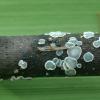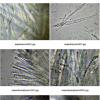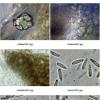
31-05-2015 20:17
 Bernard CLESSE
Bernard CLESSE
Bonsoir à tous,Je pense reconnaître ici Mollisia

05-06-2015 20:49
Peter ThompsonHello Everyone,I am puzzled by black ascomycetes w

05-06-2015 19:24
 Bernard CLESSE
Bernard CLESSE
Bonsoir à tous,Pouvez-vous me donner une piste po

03-06-2015 22:05
 Bernard CLESSE
Bernard CLESSE
Bonsoir à tous,Pouvez-vous m'aider à identifier

04-06-2015 18:28
 Bernard CLESSE
Bernard CLESSE
Bonsoir à tous,J'ai récolté hier sur akène pou

04-06-2015 15:49
 Blasco Rafael
Blasco Rafael
Hola Tengo esta muestra recogida en lasramas caida

04-06-2015 18:41
Quijada LuisHi all, I would like to ask in the forum if someb

03-06-2015 16:58
 Blasco Rafael
Blasco Rafael
Hola tengo this Muestra Recogida en el Misma Melil
 Bonsoir à tous,
Bonsoir à tous,Je pense reconnaître ici Mollisia hydrophila sur base de chaume pourri de roseau commun (Phragmites australis).
a) apothécies jaunissant au KOH
b) spores étroitement ellipsoïdes-cylindriques, avec microguttules : 8-10,5x1,5-2,8
c) paraphyses fourchues avec contenu réfringent ou nombreuses guttules
d) masses cristallines dans l'excipulum
Qu'en pensez-vous ?
Bernard


Thank you for the confirmation.
Bernard


Bernard

Following my posting of that thread Nick Aplin in the south of England emailed me - here is a part of that email:
"I've had three collections this year from separate sites in Sussex on Phragmites of what I assume is the same species as yours, but all three have differed only in the abundance of crystals; one had a few very large, irregular crystals, one had many smaller, 'envelope' shaped crystals and in one the crystals were apparently absent . . . . . . All three had the abundant subiculum and also a KOH- reaction. I have wondered whether a correlation can be made between these two characters (especially as all my collections on Phragmites without a subiculum have been distinctly KOH+)."
Chris


Hello,
in former years I have collected many times hydrophila s.l. on Phragmites and have made the same observations. The KOH reaction is sometimes clear to see, sometimes faint, sometimes absent - even in collections from the same location. A subiculum may be present or not. And the crystals may be absent too, although they are usually there.
All in common have the spore shape, which has one spore end blunt and the other pointed.
I have not realized molecular data on more than two collections, which both were quite typical, and which both fell together in the tree. It would be good to have these different collections to see wether it is one variablespecies or a species complex.
best regards,
Andreas

These are interesting results! I hope you have documented the two sequenced ones or noted their peculiarities to allow interpretation of further genetic results.
Zotto


